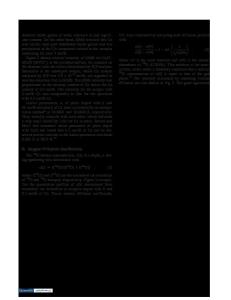Phosphorus Oxide Assisted n-type Dopant Diffusion in 4H-Silicon Carbide
- PDF / 305,485 Bytes
- 6 Pages / 612 x 792 pts (letter) Page_size
- 11 Downloads / 393 Views
1246-B07-12
Phosphorus Oxide Assisted n-type Dopant Diffusion in 4H-Silicon Carbide Suwan P. Mendis and Chin-Che Tin Department of Physics, Auburn University, Auburn, AL 36849, U.S.A.
ABSTRACT Phosphorus is an important n-type dopant for both silicon and silicon carbide. Although solid-state diffusion of phosphorus in silicon has been well documented and experimentally proven, not much is known about phosphorus solid-state diffusion in silicon carbide, especially at lower temperatures. A convenient source of phosphorus for solid-state diffusion in silicon carbide is phosphorus oxide. The possibility of using phosphorus oxide as a dopant source for silicon carbide is investigated by considering the probable reactions between silicon carbide and phosphorus oxide at temperatures below 1700 K using published thermodynamic data. By considering the standard free energies of reactions, it can be shown that phosphorus can be introduced in silicon carbide at temperatures below 1700 K using phosphorus oxide. A successful development of low temperature dopant incorporation in silicon carbide would reduce the need for high temperature processes and prevent process-induced thermal degradation of critical device structures such as the oxide-semiconductor interface. Experimental results showing phosphorus impurity incorporation and activation in 4H-SiC are presented. INTRODUCTION Silicon carbide (SiC) is a wide band gap semiconductor with physical and electronic properties highly suitable for high temperature and high power electronics. Considerable progress has been made during the last few decades in SiC device technology which has led to the fabrication of a variety of high temperature, high power, and high frequency devices such as MESFET’s, MOSFET’s, thyristors, and SIT’s [1]. In spite of significant progress in SiC material and device technology, there are still pressing issues in metallization that require good, reliable ohmic contacts [2] and high concentration doping [3]. As in any semiconductor, doping is an important process in SiC to make p-n junctions, ohmic contacts, and the active layers of SiC devices. The commonly used doping methods in SiC device processing include in-situ doping during epitaxial growth [4,5], thermal diffusion [6,7], and ion implantation [8-10]. These methods invariably require specialized equipment and elaborate processing protocol involving high temperature annealing in excess of 1900 K. A low temperature processing technique for dopant incorporation and activation in SiC, that is both simple and effective, would be useful for low-budget fabrication of SiC devices. Unless dopants can be introduced into SiC in large concentrations, transition metals tend to form rectifying contacts on SiC in the as-deposited state [11]. A dopant concentration of at least ≈ 1019 cm-3 is required to produce ohmic contacts [11,12]. When using nitrogen, which is a commonly used n-type dopant for SiC, the free carrier concentration saturates at ≈ 1019 cm-3. hence, phosphorus can be used as an alternative dopant to
Data Loading...





